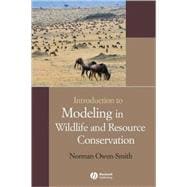
Note: Supplemental materials are not guaranteed with Rental or Used book purchases.
Purchase Benefits
Looking to rent a book? Rent Introduction to Modeling in Wildlife and Resource Conservation [ISBN: 9781405144391] for the semester, quarter, and short term or search our site for other textbooks by Owen-Smith, Norman. Renting a textbook can save you up to 90% from the cost of buying.
| Preface | |
| Introduction: Why Learn Modeling? | |
| A Starting Problem: Conservation of the Dodo | |
| Descriptive Models: Choosing an Equation | |
| Structured Population Models: Age, Size, or Stage | |
| Consumer-Resource Models: Population Interactions | |
| Simulation Models: Assessing Understanding | |
| Harvesting Models: Adaptive Management | |
| Population Viability Models: Risk Analysis | |
| Metapopulation Models: Spreading the Risk | |
| Modeling Infectious Diseases: Outbreak Dynamics | |
| Scenario Models: Exploring Options | |
| Vegetation Models: Biomass to Gap Dynamics | |
| State Transition Models: Habitat Patch Dynamics | |
| Habitat Suitability Models: Adaptive Behavior | |
| Reconciling Models With Data: Statistical Diagnosis | |
| Appendices | |
| References | |
| Table of Contents provided by Publisher. All Rights Reserved. |
The New copy of this book will include any supplemental materials advertised. Please check the title of the book to determine if it should include any access cards, study guides, lab manuals, CDs, etc.
The Used, Rental and eBook copies of this book are not guaranteed to include any supplemental materials. Typically, only the book itself is included. This is true even if the title states it includes any access cards, study guides, lab manuals, CDs, etc.